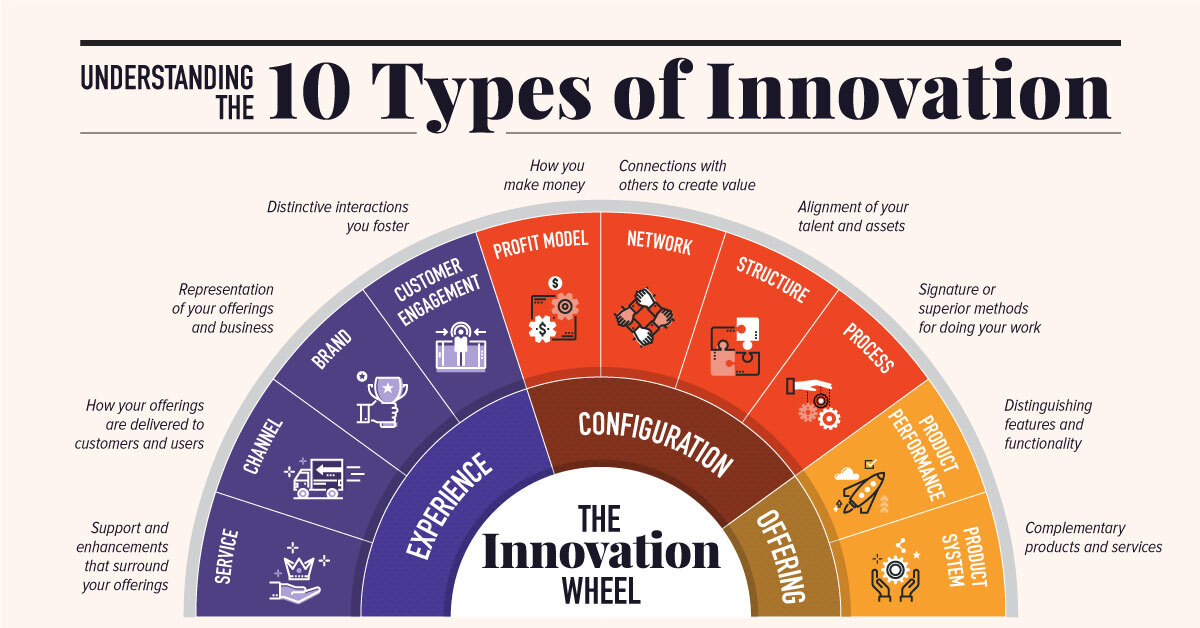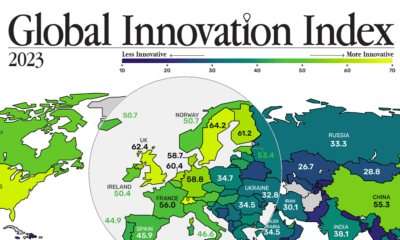Technology
10 Types of Innovation: The Art of Discovering a Breakthrough Product
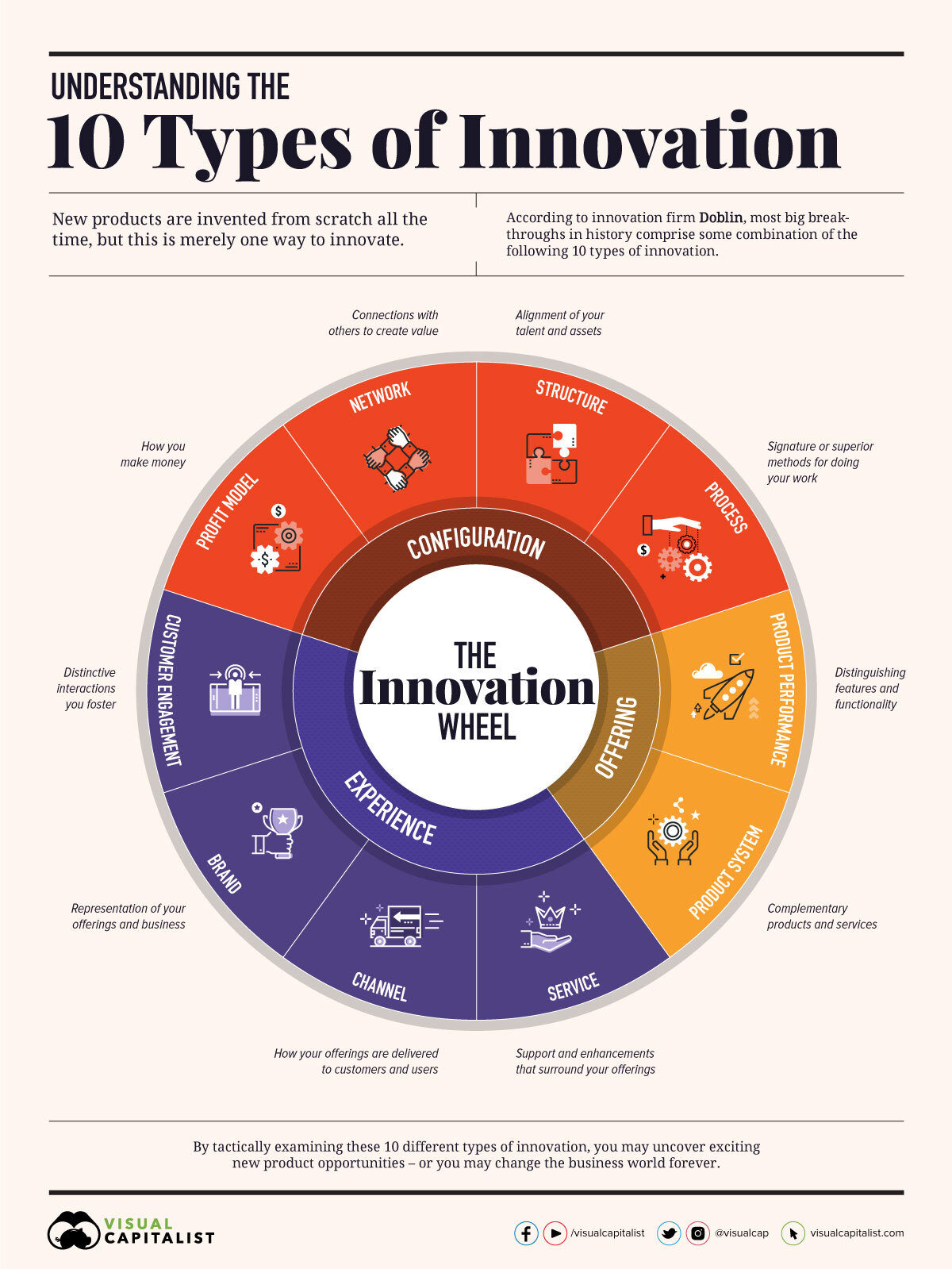
The Art of Discovering Breakthrough Products
As venture capitalist Peter Thiel once put it, “competition is for losers.”
It’s inevitable that every company must be out there battling for market share, but you don’t really want to be in a situation where the competition is so stiff that any potential upside is eroded away in the process—―a scenario known as perfect competition in economics.
To avoid perfect competition, companies must strive to build an economic moat that gives them a sustainable competitive advantage over time. While these protective moats can arise from a number of different sources, in today’s information economy they most often arise from the power of innovation.
But where does innovation come from, and is there a universal framework that can be applied to help consistently make big breakthroughs?
The 10 Types of Innovation
In today’s infographic, we showcase the culmination of years of in-depth research from Doblin, an innovation-focused firm now owned by Deloitte.
After examining over 2,000 business innovations throughout history, Doblin uncovered that most breakthroughs don’t necessarily stem from engineering inventions or rare discoveries.
Instead, they observed that innovations can be categorized within a range of 10 distinct dimensions—and anyone can use the resulting strategic framework to analyze the competition, to stress test for product weaknesses, or to find new opportunities for their products.
Here are the 10 types of innovation:
| # | Innovation Type | Description |
|---|---|---|
| 1. | Profit Model | How you make money |
| 2. | Network | Connections with others to create value |
| 3. | Structure | Alignment of your talent and assets |
| 4. | Process | Signature of superior methods for doing your work |
| 5. | Product Performance | Distinguishing features and functionality |
| 6. | Product System | Complementary products and services |
| 7. | Service | Support and enhancements that surround your offerings |
| 8. | Channel | How your offerings are delivered to customers and users |
| 9. | Brand | Representation of your offerings and business |
| 10. | Customer Engagement | Distinctive interactions you foster |
From Theory to Practice
What does innovation look like in practice?
Let’s see how well-known businesses have leveraged each of these 10 types of innovation in the past, while also diving into the tactics that modern businesses can use to consistently make new product breakthroughs:.
Innovation Types #1-4: “Configuration”
According to Doblin, the first four types of innovation center around the configuration of the company, and all the work that happens “behind the scenes”.
Although innovation types in this category are not directly customer-facing, as you can see in the examples below, they can still have an important impact on the customer experience. How your company and products are organized can have a crucial downstream effect, even enabling innovations in other categories.
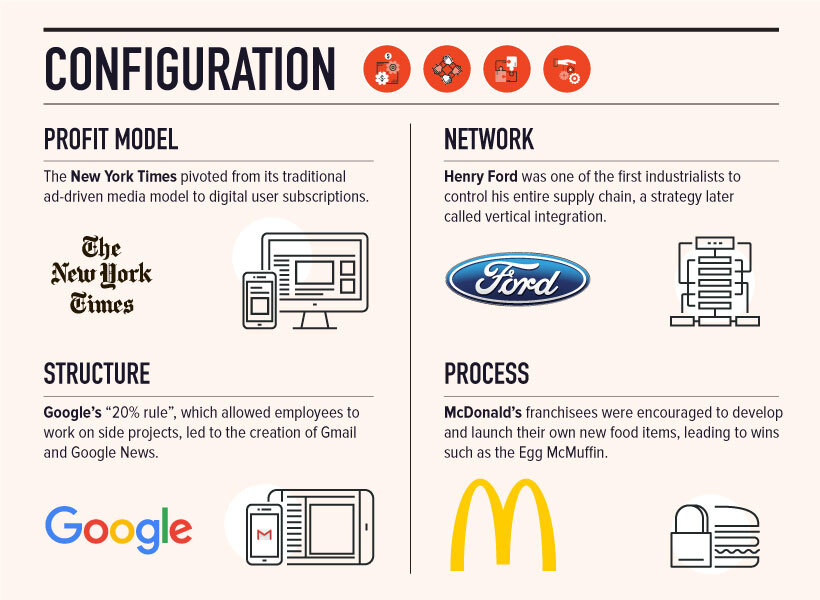
Two of the most interesting examples here are Google and McDonald’s. Both companies made internal innovations that empowered their people to make important advancements further on downstream.
In the case of McDonald’s, the franchisee insight that led to the introduction of the Egg McMuffin spearheaded the company’s entire breakfast offering, which now accounts for 25% of revenues. Breakfast is also now the company’s most profitable segment.
Innovation Types #5-6: “Offering”
When most people think of innovation, it’s likely the offering category that comes to mind.
Making improvements to product performance is an obvious but difficult type of innovation, and unless it’s accompanied by a deeply ingrained company culture towards technical innovation, such advancements may only create a temporary advantage against the competition.
This is the part of the reason that Doblin recommends that companies focus on combining multiple areas of innovation together—it creates a much more stable economic moat.
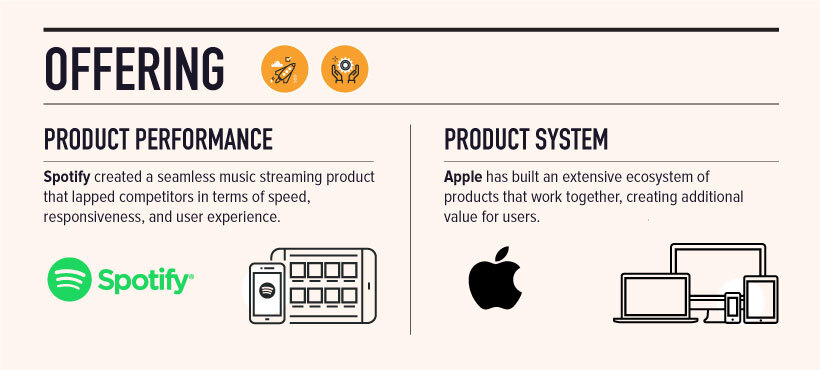
Apple has a reputation for innovation, but the product ecosystem highlighted above is an underappreciated piece of the company’s strategy. By putting thought into the ecosystem of products—and ensuring they work together flawlessly—additional utility is created, while also making it harder for customers to switch away from Apple products.
Innovation Types #7-10: “Experience”
These types of innovation are the most customer-facing, but this also makes them the most subject to interpretation.
While other innovations tend to occur upstream, innovations in experience all get trialed in the hands of customers. For this reason, intense care is needed in rolling out these ideas.
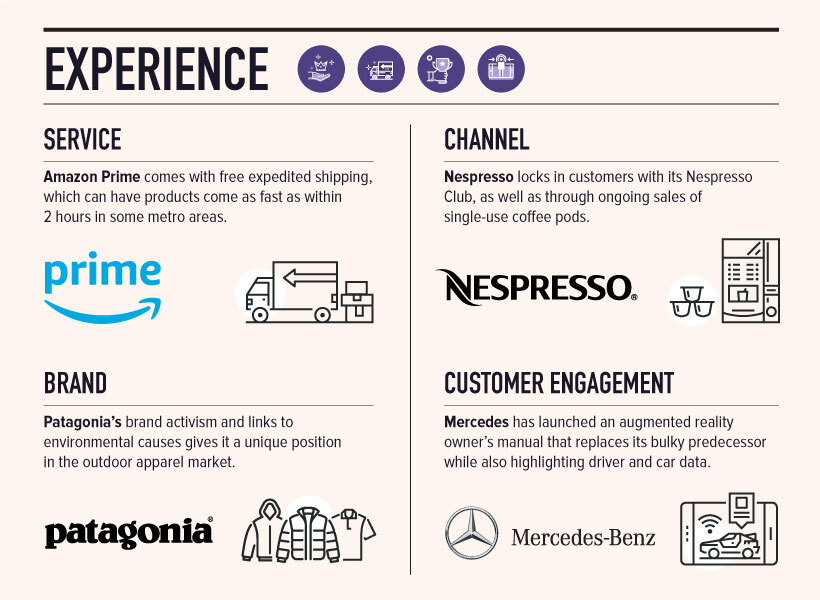
In the early days of the internet, online shipping was precarious at best—but Amazon’s introduction of Amazon Prime and free expedited shipping for all members has been a game-changer for e-commerce.
Executing on such a promise was no small task, but today there are 150 million users of Prime worldwide, including some in metro areas who can get items in as little as two hours.
Making Innovations Happen in Your Organization
How can organizations approach the 10 types of innovation from a more tactical perspective?
One useful resource is Doblin’s free public list of over 100 tactics that correspond with the aforementioned framework.
The one-pager PDF provides a range of typical dimensions for approaching each type of innovation. In essence, these are all different ways you could consider when trying to differentiate your product or service—and at the very least, it provides a useful thought experiment for managers and marketers.
For those interested in learning more on this topic, Doblin also has a highly-rated book as well as other accessories that leverage the above framework.
Technology
Ranked: Semiconductor Companies by Industry Revenue Share
Nvidia is coming for Intel’s crown. Samsung is losing ground. AI is transforming the space. We break down revenue for semiconductor companies.
Semiconductor Companies by Industry Revenue Share
This was originally posted on our Voronoi app. Download the app for free on Apple or Android and discover incredible data-driven charts from a variety of trusted sources.
Did you know that some computer chips are now retailing for the price of a new BMW?
As computers invade nearly every sphere of life, so too have the chips that power them, raising the revenues of the businesses dedicated to designing them.
But how did various chipmakers measure against each other last year?
We rank the biggest semiconductor companies by their percentage share of the industry’s revenues in 2023, using data from Omdia research.
Which Chip Company Made the Most Money in 2023?
Market leader and industry-defining veteran Intel still holds the crown for the most revenue in the sector, crossing $50 billion in 2023, or 10% of the broader industry’s topline.
All is not well at Intel, however, with the company’s stock price down over 20% year-to-date after it revealed billion-dollar losses in its foundry business.
| Rank | Company | 2023 Revenue | % of Industry Revenue |
|---|---|---|---|
| 1 | Intel | $51B | 9.4% |
| 2 | NVIDIA | $49B | 9.0% |
| 3 | Samsung Electronics | $44B | 8.1% |
| 4 | Qualcomm | $31B | 5.7% |
| 5 | Broadcom | $28B | 5.2% |
| 6 | SK Hynix | $24B | 4.4% |
| 7 | AMD | $22B | 4.1% |
| 8 | Apple | $19B | 3.4% |
| 9 | Infineon Tech | $17B | 3.2% |
| 10 | STMicroelectronics | $17B | 3.2% |
| 11 | Texas Instruments | $17B | 3.1% |
| 12 | Micron Technology | $16B | 2.9% |
| 13 | MediaTek | $14B | 2.6% |
| 14 | NXP | $13B | 2.4% |
| 15 | Analog Devices | $12B | 2.2% |
| 16 | Renesas Electronics Corporation | $11B | 1.9% |
| 17 | Sony Semiconductor Solutions Corporation | $10B | 1.9% |
| 18 | Microchip Technology | $8B | 1.5% |
| 19 | Onsemi | $8B | 1.4% |
| 20 | KIOXIA Corporation | $7B | 1.3% |
| N/A | Others | $126B | 23.2% |
| N/A | Total | $545B | 100% |
Note: Figures are rounded. Totals and percentages may not sum to 100.
Meanwhile, Nvidia is very close to overtaking Intel, after declaring $49 billion of topline revenue for 2023. This is more than double its 2022 revenue ($21 billion), increasing its share of industry revenues to 9%.
Nvidia’s meteoric rise has gotten a huge thumbs-up from investors. It became a trillion dollar stock last year, and broke the single-day gain record for market capitalization this year.
Other chipmakers haven’t been as successful. Out of the top 20 semiconductor companies by revenue, 12 did not match their 2022 revenues, including big names like Intel, Samsung, and AMD.
The Many Different Types of Chipmakers
All of these companies may belong to the same industry, but they don’t focus on the same niche.
According to Investopedia, there are four major types of chips, depending on their functionality: microprocessors, memory chips, standard chips, and complex systems on a chip.
Nvidia’s core business was once GPUs for computers (graphics processing units), but in recent years this has drastically shifted towards microprocessors for analytics and AI.
These specialized chips seem to be where the majority of growth is occurring within the sector. For example, companies that are largely in the memory segment—Samsung, SK Hynix, and Micron Technology—saw peak revenues in the mid-2010s.
-

 Real Estate2 weeks ago
Real Estate2 weeks agoVisualizing America’s Shortage of Affordable Homes
-

 Technology1 week ago
Technology1 week agoRanked: Semiconductor Companies by Industry Revenue Share
-

 Money1 week ago
Money1 week agoWhich States Have the Highest Minimum Wage in America?
-

 Real Estate1 week ago
Real Estate1 week agoRanked: The Most Valuable Housing Markets in America
-

 Business2 weeks ago
Business2 weeks agoCharted: Big Four Market Share by S&P 500 Audits
-

 AI2 weeks ago
AI2 weeks agoThe Stock Performance of U.S. Chipmakers So Far in 2024
-

 Misc2 weeks ago
Misc2 weeks agoAlmost Every EV Stock is Down After Q1 2024
-

 Money2 weeks ago
Money2 weeks agoWhere Does One U.S. Tax Dollar Go?

